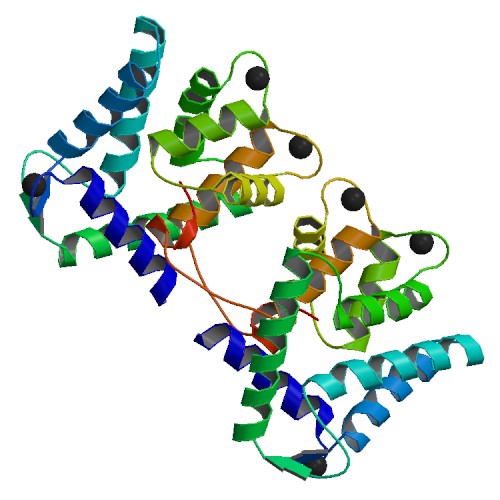Part:BBa_K548000
Humanized Aequorin
This BioBrick is a human cell line optimized version of Aequorin, a bioluminescent protein found in various jellyfish and other marine organisms. Aequorin was discovered in Aequorea aequorea, a species of bioluminescent jellyfish first purified in 1962 by Osamu Shimomura[1]. The protein requires Ca2+ for catalytic activity and oxidizes its substrate, coelenterazine to emit blue light (λmax=469nm)[1]. Aequorin is NOT a fluorescent protein, it does not require an excitation light source to emit light. Transfection of the gene into 293T cells using lipofectamine has been confirmed. The part contains EcoRI and PstI restrictions sites, and is ligated to the iGEM pSB1C3 backbone. This backbone provides chloramphenicol resistance.
Usage and Biology
This protein emitted light at the correct wavelength, and required calcium as a cofactor, which allowed us to easily adapt it for use in our light activated ion channel cell signaling system. In the presence of its substrate, coelenterazine and the Ca2+ cofacter, Aequorin emits a rapid burst of blue light.
Characterization
We characterized our new biobrick with a series of experiments intended to show two things:
1.Our newly synthesized gene could produce a measurable quantity of blue light
2.Our newly synthesized gene could only produce light in the presence of Ca2+
To do this, we transfected 293T cells with our gene contained in the pRRL mammalian expression vector using lipofectamine (Aeq 293T), a common and well characterized transfection reagent. After transfection, cells were lysed using Promega Passive Lysis Buffer (PLB) and the lysate was mixed with either nothing, only coelenterazine, only Ca2+, or both coelenterazine and Ca2+. Then, samples were placed into a luminometer and the luminescence was recorded. The results are summarized in the graph below.
As our luminometer experiments show, both Ca2+ and coelenterazine are required for substantial production of light. In fact, when compared to Aequorin alone, a mixture of Ca2+ and coelenterazine produced more than 10000 times more light. Furthermore, note that a lack of Ca2+ reduced light output by 1000 times, when compared to the light output of Aequorin in the presence of Ca2+ and coelenterazine. Through this experiment, we have shown that not only can our biobrick produce blue light, but that this production of light is heavily Ca2+ dependent.
Properties
Transcript Size: ~22kDa
Gene Length: 618 bp
Optimization: Optimized for use in mammalian cells ONLY. For expression in bacteria see Part:BBa_K222000
Confirmed Working Vectors: pRRL, pSB1C3 (iGEM 2011 biobrick backbone)
Transfected Cells: HEK 293T cells
Transfection Reagents: Lipofectamine
References
[1]Shimomura, Osamu, Frank H Johnson, and Yo Saiga. "Extraction, Purification and Properties of Aequorin, a Bioluminescent Protein from the Luminous Hydromedusan, Aequorea." Journal of Cellular and Comparative Physiology 59.3 (2005): 223-239. Wiley Online Library. Web. 28 Sept. 2011. <http://onlinelibrary.wiley.com/doi/10.1002/jcp.1030590302/pdf>.
Sequence and Features
- 10COMPATIBLE WITH RFC[10]
- 12COMPATIBLE WITH RFC[12]
- 21COMPATIBLE WITH RFC[21]
- 23COMPATIBLE WITH RFC[23]
- 25INCOMPATIBLE WITH RFC[25]Illegal NgoMIV site found at 62
Illegal NgoMIV site found at 226 - 1000COMPATIBLE WITH RFC[1000]
| None |



